 Overview
Overview
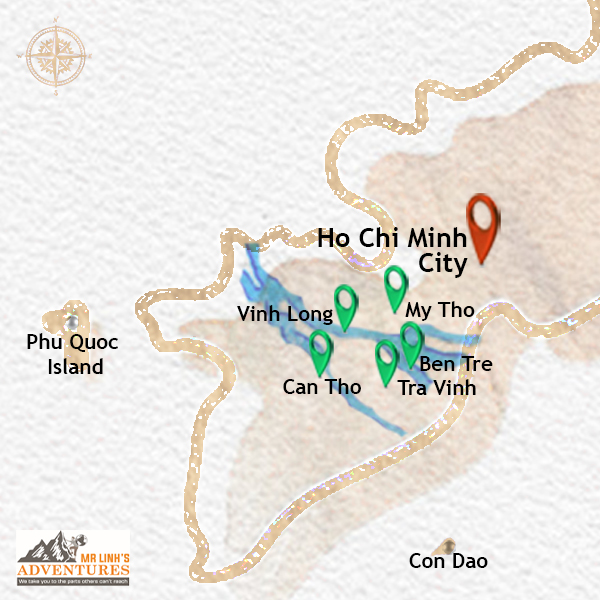 The Mekong Delta
The Mekong Delta, an enchanting labyrinth of waterways, verdant rice paddies, and picturesque villages, is an essential destination for travelers seeking authenticity and adventure.
Located in southern Vietnam, this natural gem offers a unique immersion into the local culture, a journey along the water's edge to encounter captivating landscapes and warm communities. At sunrise, the Mekong Delta comes alive with a colorful mosaic: the floating markets. Small wooden boats, laden with fresh fruits and vegetables, converge in an unceasing ballet, ready to trade their goods.
Formerly Khmer territory, the Mekong Delta, which came under Vietnamese rule in the 17th century, was the scene of bloody conflicts during the French colonial period and the Vietnam War. Today, it is a haven of peace, where agriculture flourishes and feeds an entire country. Nicknamed the "rice bowl of Vietnam," the delta is one of the country's main rice producers, thanks to its fertile land and favorable climate. Sugar cane, soybeans, and fruits are also grown in abundance, ensuring the livelihood of many families.
 Top Attractions
Top Attractions
The Mekong Delta, a vibrant labyrinth of waterways in southern Vietnam, offers a unique and immersive experience. Beyond its lush landscapes and bountiful harvests, it's a world where life revolves around the river. Embark on a journey to discover the heart of this region, where the rhythm of daily life is inextricably linked to the ebb and flow of the Mekong. Here are a few must-see experiences that encapsulate the magic of this extraordinary place.
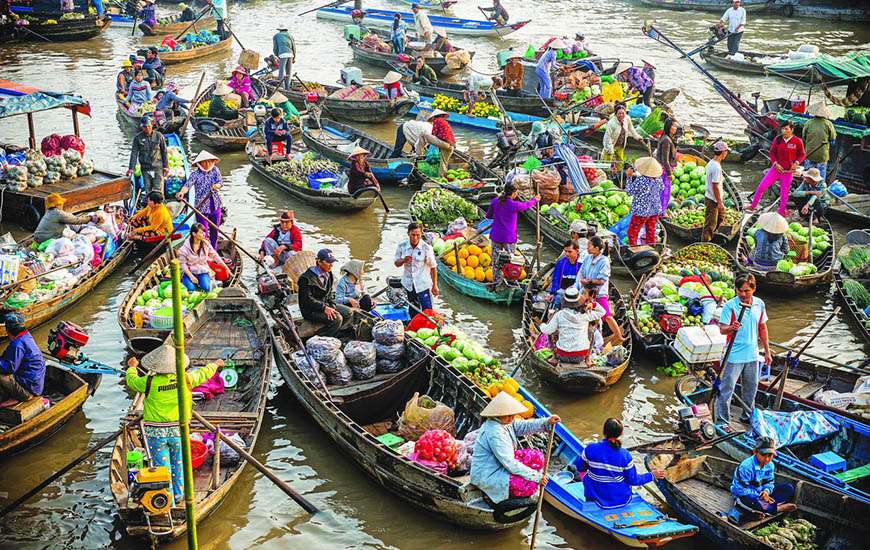 Floatting markets, emblem of Mekong Delta - Internet
Floatting markets, emblem of Mekong Delta - InternetFloating Markets
A symphony of colors and commerce unfolds as vendors navigate their laden boats, creating a lively spectacle of trade and tradition.
Sampan Rides
Tranquil waterways reveal a world of stilt houses and verdant water palms, offering a glimpse into the serene rhythm of Delta life.
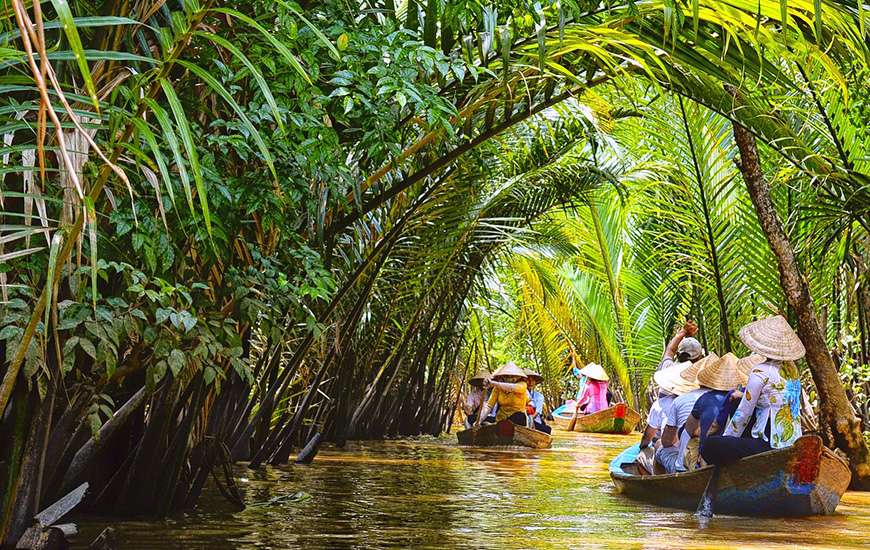 Walk through the arroyos in the vicinity of Cai Be - Internet
Walk through the arroyos in the vicinity of Cai Be - InternetLuxuriant Orchards
Taste the sweetness of the Delta's bounty, where sun-kissed fruits flourish and the secrets of tropical cultivation are revealed.
Pagodas and Temples
Discover the spiritual heart of the Delta, where ancient pagodas and temples stand as serene testaments to the region's rich cultural heritage.
 See & Do
See & Do
The Mekong River in My Tho - Mr Linh's Adventures Team
Visiting the Flagship Cities of the Southern Delta
My Tho
Easily accessible from Ho Chi Minh City, My Tho has become a popular destination for tourists, who embark by the thousands aboard sampans to discover the beauty of the Mekong. Along the banks, the colorful facades of the houses pile up and the balconies extend over the river, offering a picturesque spectacle. My Tho is also a pleasant town to explore on foot, with its architectural gem, the Vinh Trang Temple. The latter, remarkable for its blend of Vietnamese, Cambodian, Chinese, and European styles, houses magnificent statues of Buddha, sitting or standing, which welcome visitors.
Phoenix Island, near My Tho, is home to a place steeped in history and strangeness: the former residence of the coconut monk. Nguyen Thanh Nam, an eccentric figure, founded a syncretic religion there, a mixture of Buddhism and Christianity, and meditated for three years, it is said, on a stone slab, feeding himself exclusively on coconuts. Although this religion has disappeared, the island retains vestiges of this era, notably astonishing colorful constructions, including a model of the Apollo rocket.
Ben Tre
Ben Tre, the realm of the coconut, is famous for its artisanal candies, sweet and sticky treats that are savored with delight. Beyond the river trips, a visit to a coconut factory is an enriching experience to discover the local know-how. The mountains of coconuts and the shells that line the rivers testify to the importance of this crop. Inside the factories, men and women work with impressive dexterity to transform the coconut flesh into tasty candies. Visitors can thus follow the manufacturing process, from harvesting to tasting.
Ben Tre is also renowned for its mat craftsmanship, perpetuated by passionate artisans.
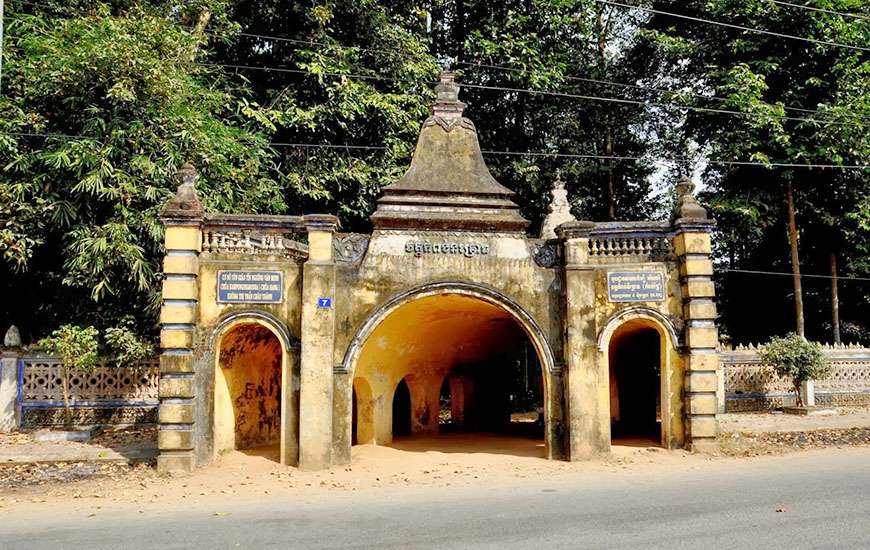 Indian-Khmer architecture for this Chua Hang, in Tra Vinh - Internet
Indian-Khmer architecture for this Chua Hang, in Tra Vinh - InternetTra Vinh
In Tra Vinh, the Khmer kingdom has not disappeared. More than 140 pagodas, architectural jewels, dot the landscape, testifying to a living and spiritual culture. Here, Theravada Buddhism is practiced with fervor, and the Khmer language continues to be passed on. The Hang Pagoda, one of the most beautiful in the region, is a place of meditation and contemplation. But it is also a place where nature expresses itself with force: the storks, majestic, fly over the temple, offering an unforgettable spectacle.
Vinh Long
Vinh Long, in the heart of the Mekong Delta, is an invitation to discover river life. Surrounded by rivers and canals, the city is an ideal place to stay with locals and soak up the peaceful rhythm of the river. Vinh Long is also a privileged starting point for an excursion to Cai Be, where the floating market, with its bright colors and lively atmosphere, is an unmissable spectacle. Although the market is at its peak around 6 o'clock in the morning, the activity continues in the afternoon.
Chau Doc
Chau Doc, a border town with Cambodia, is a true crossroads of cultures. Vietnamese, Chinese, Cham, and Khmer people live side by side in astonishing harmony. The pastel-colored houses and the varied architecture of the temples, mosques, and pagodas contribute to the charm of this welcoming city, where diversity is a richness. Not far from there, the sacred mountain of Sam attracts many Buddhist pilgrims each year. Dotted with temples and pagodas nestled in the crevices and caves, its ascent is a true spiritual quest. At the summit, the reward is equal to the effort: a breathtaking view of the surrounding lands, between Vietnam and Cambodia, is offered to amazed eyes.
 Go Green
Go Green
Mr. Linh's Adventures offers tailor-made tours, designed to give you an authentic and unforgettable experience in the Mekong Delta. Our passionate and experienced local guides will accompany you in your discovery of the region, sharing their knowledge and love for their country.
 Heritage
Heritage
Huynh Thuy Le ancient house - Internet
The Mekong Delta is a region rich in history and culture. In Sa Dec, you can visit historic sites, such as the house of Huynh Thuy Le, made famous by Marguerite Duras' novel "The Lover." In Tay Ninh, it is the astonishing Cao Dai Temple, a unique place of worship, which will not fail to surprise you.
Meeting Local Communities
While the Kinh, also known as Viets, constitute the majority group in Vietnam (about 85% of the population), other ethnic groups contribute to the cultural richness of Vietnam.
The Khmer
The Khmer, or Khmer Krom, are one of the indigenous ethnicities of the delta, with a deep history in the region. Their population is estimated at around 1.3 million people, making them the second largest ethnic group after the Kinh. Their way of life is closely linked to fishing and agriculture, and their culture is strongly influenced by Theravada Buddhism.
The Chinese (Han)
The Chinese, of the Han group, are also present in the Mekong Delta, mainly in urban and coastal areas. They exert a significant cultural influence, particularly through their cuisine and festivals, thus enriching the cultural diversity of the region.
The Cham
The Cham, a Malayo-Polynesian group, live mainly in the coastal regions of south-central Vietnam and in some urban areas of the delta. They retain matrilineal traditions and a distinct culture, linked to the sea, adding a maritime dimension to the cultural mosaic of the delta.
Other Ethnic Groups
Other ethnic groups, such as the S'Tiêng and Tibeto-Burman communities, are also present in certain parts of the Mekong Delta. Although their numbers are relatively small compared to the Kinh and Khmer, their presence contributes to the cultural diversity of the region, testifying to the richness and complexity of the delta's history.
The U Minh Forest, a sanctuary of wild nature - Internet
The U Minh Forest
The U Minh Forest, of exceptional beauty, is a sanctuary of wild nature. Its mangroves, among the largest in the world after the Amazon, are home to remarkable fauna. The intertwined roots of the mangrove trees emerge from the murky waters, their slender trunks rising towards the sky in an explosion of greenery. To penetrate this forest is to go back in time, to the era when nature was devoid of any human presence. The majestic trees and mysterious waters evoke unexplored worlds, and the immersion in this dense forest arouses a palpable anticipation.
During the Vietnam War, the American forces massively used chemical defoliants, causing devastation to the vegetation and seriously affecting the health of the populations. These toxic products, deadly for plants and devastating for humans, deeply marked the region. Yet, nature has reclaimed its rights. The U Minh Forest has regained its splendor, and it is difficult to imagine the scars of its past. Boat trips are now organized daily, offering visitors the opportunity to admire the richness of the fauna, with rare species such as the fishing cat, the hairy-nosed otter, and 187 species of birds.
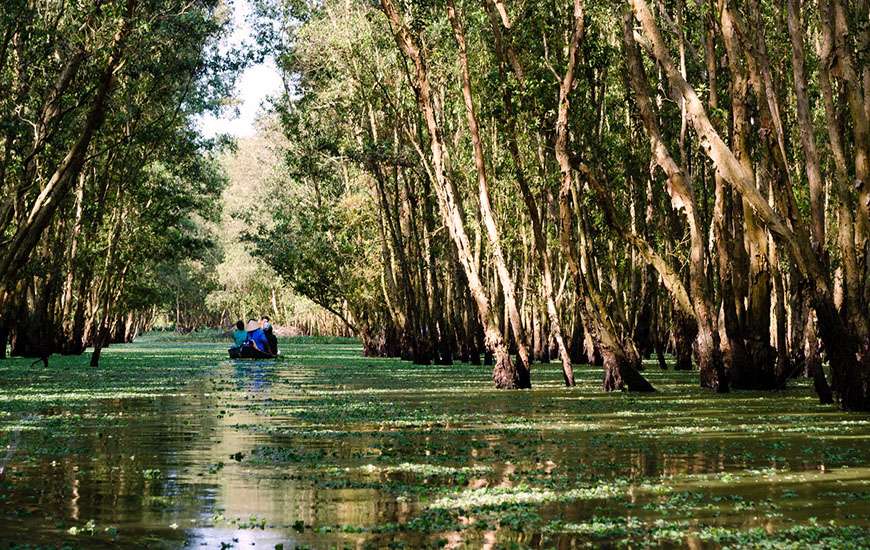 Magical Tra Su flooded forest - Internet
Magical Tra Su flooded forest - InternetTra Su
About thirty kilometers south of Chau Doc, the flooded forest of Tra Su is a true enchantment. This ornithological reserve is home to a multitude of bird species, which visitors can observe during boat trips through the rivers bordered by water lettuce. As you go along the water, the landscapes follow one another, between forests of cajeput trees and mangrove trees, in an incessant aerial ballet. In the afternoon, the forest comes alive to the sound of birdsong, offering a unique sound spectacle. The ride ends with an ascent of the watchtower, which offers a breathtaking view of the entire forest. In addition to the birds, the forest also shelters swarms of bees, whose fresh and tasty honey is sold on site.
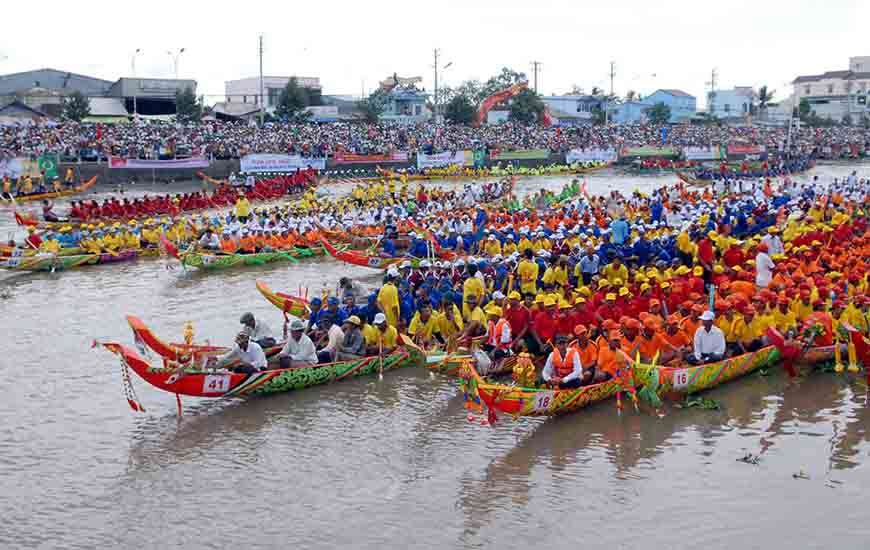 Ok Om Bok, a Khmer Festival in Mekong Delta - Internet
Ok Om Bok, a Khmer Festival in Mekong Delta - InternetFestivals and Celebrations
The Mekong Delta is a land of traditions and festivals. In addition to Tet, the Vietnamese New Year, many villages celebrate Chol Chnam Thmay, the Khmer New Year, in April. For three days, the festivities are in full swing: offerings, prayers, teachings of the monks, traditional games and dances punctuate these moments of sharing and joy. Later in the year, the Ok Om Bok festival, dedicated to the god of the moon, offers a unique spectacle. On the full moon of the tenth month, families gather to make offerings, before going to the Ba Om pond, in Tra Vinh. There, colorful lanterns and traditional music illuminate the night, while traditional boat races, the ngo, add a touch of competition and enthusiasm to the party.
 Food & Drinks
Food & Drinks
Deep-fried elephant ear fish is very popular in the Mekong Delta region-Internet
The cuisine of the Mekong Delta is a true festival of flavors, mixing Vietnamese, Chinese and Khmer influences.
Ca tai tuong chien xu
From the Mekong Delta comes deep-fried elephant ear fish, a specialty where the fish is deep-fried until crispy. It's often served wrapped in rice paper with cucumbers, pickles, and herbs, showcasing its tender meat.
Ca Tai Tuong
Ca Tai Tuong, also known as "elephant ear fish", is a spectacular dish, consisting of a fried fish served whole. It is often accompanied by fresh vegetables and a sweet and sour sauce. A dish to be enjoyed without hesitation for fish lovers.
Bun Mam
Bun Mam is a rice noodle soup based on fermented fish broth, garnished with fresh vegetables and sometimes seafood. A typical dish of the Delta, with a pronounced and authentic taste, which will delight lovers of marine flavors.
Lẩu Mắm
Lẩu Mắm is a fondue based on fermented fish, often prepared with different types of fish and served with fresh vegetables and rice vermicelli. A convivial dish, ideal for sharing a tasty and warm meal.
Banh Cong
Banh Cong, originating from Soc Trang, is a kind of crispy cake, made from a mixture of rice and wheat flour. It is often served with a sweet and sour sauce. A local specialty to discover during your trip to the Delta.
Hu Tieu
A seafood vermicelli soup, typical of the city of My Tho, which is distinguished by its rich broth and fresh ingredients.
Cá Lóc Nướng Trui
This dish consists of a snakehead fish grilled on a stick, often served with fresh herbs and a tamarind-based sauce.
 Directions
Directions
Location
The Mekong Delta is located about 200 km south of Ho Chi Minh City and 1,700 km south of Hanoi.
How to get there
You can reach the Delta by bus, car or plane from these two cities. Ticket prices vary depending on the mode of transport and the company chosen.
Best time to visit
The best season to visit the Mekong Delta is from December to April, during the dry season, when the sun is out and the temperatures are pleasant.
Do not hesitate to
contact us to organize your tailor-made trip to the Mekong Delta. We will be happy to advise you and accompany you in this unforgettable adventure.